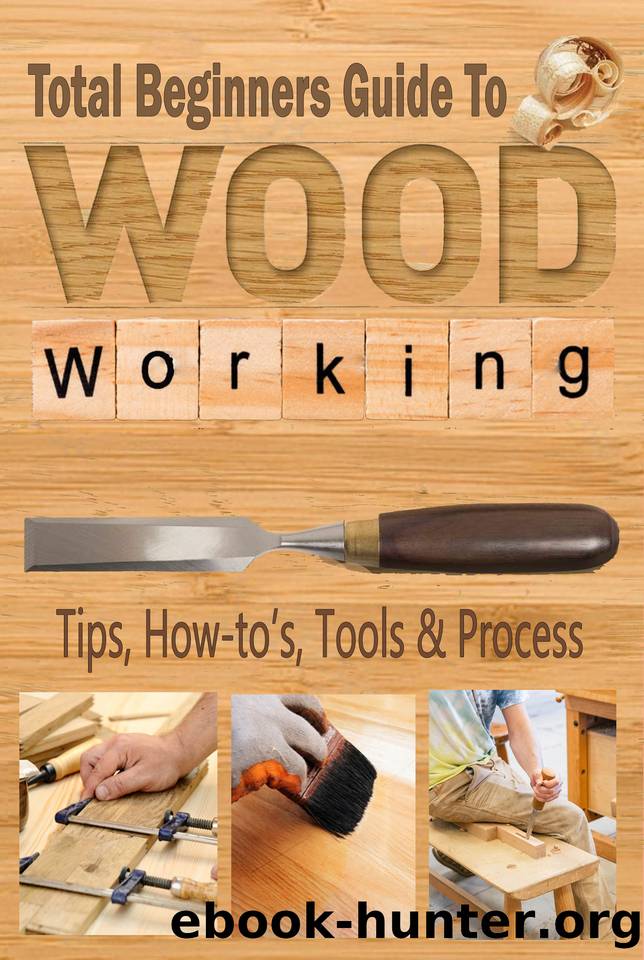Total Beginners Guide To Woodworking: Tips, How-to’s, Tools & Process by Dutton Dori

Author:Dutton, Dori [Dutton, Dori]
Language: eng
Format: epub
Published: 2020-07-27T16:00:00+00:00
B. Types of Nails:
1. Box Nail
Description: Essentially common nails, but with a thinner shank.
Application: Light construction and household use.
2. Brad Nail
Description: 18 gauge nails with small round heads. Easy to mask in the wood trim.
Application: Trim, moldings, cabinetry, and light DIY woodworks.
3. Common Nail
Description: Everyday nails with lengths varying from one to six inches.
Application: Most medium to heavy framing, construction, and carpentry works.
4. Finishing Nail
Description: Nails made up of 15 or 16 gauge wire with barrel-shaped heads. They are suitable for finish work.
Application: Installing paneling and trim.
5. Masonry Nail
Description: Nails specially designed to penetrate the plaster wall without tearing it down.
Application: Masonry walls.
6. Roofing Nail
Description: Characterized by disproportionately large and round heads and heavier shafts. These nails are specially designed to affix roofing materials.
Application: Roofing.
7. Upholstery Nail / Tacks
Description: Available in round and cut form, these nails have decorative heads.
Application: Hold carpet or fabric to wood.
C. How Do You Nail Wood without Splitting It?
You need to pound down the tip of the nail before hammering it in the wood. The slightly blunted nail will penetrate the piece of wood without splitting it.
D. What Length of the Nail Is Needed?
Usually, the nail should be at least three times the length of the object you intend to hammer it with. The measurement unit for nails is Pennies. The symbol is “d.” Here’s a table showing nail lengths in pennies and inches.
2d = 1 inch 9d = 2 3/4 inches
3d = 1 1/4 inches 10d = 3 inches
4d = 1 1/2 inches 12d = 3 1/4
inches
5d = 1 3/4 inches 16d = 3 1/2
inches
6d = 2 inches 20d = 4 inches
7d = 2 1/4 inches 30d = 4 1/2
inches
8d = 2 1/2 inches 40d = 5 inches
3. Screws
Screws are also essential wood fasteners. You can use them in a variety of woodworking projects.
A. Parts of a Screw
Drive – The two most common types of wood screw drives are slotted and Phillips.
Head – Most screws have flat heads, others have oval and round ones.
Shank – Shank is the area between head and thread. Fully threaded screws don’t have shank.
Thread – Threads reduce friction when a screw drives into the wood, stopping it from splitting.
Tip – Self-drilling screws have a pointed tip and machine screws have a blunt tip.
Download
This site does not store any files on its server. We only index and link to content provided by other sites. Please contact the content providers to delete copyright contents if any and email us, we'll remove relevant links or contents immediately.
On Writing A Memoir of the Craft by Stephen King(4853)
The Doodle Revolution by Sunni Brown(4673)
A Simplified Life by Emily Ley(4086)
Mummy Knew by Lisa James(3626)
Marijuana Grower's Handbook by Ed Rosenthal(3612)
Better Homes and Gardens New Cookbook by Better Homes & Gardens(3512)
Figure Drawing for Artists by Steve Huston(3367)
Paper Parties by Erin Hung(3359)
Draw Your Day by Samantha Dion Baker(3265)
The Genius of Japanese Carpentry by Azby Brown(3216)
Japanese Design by Patricia J. Graham(3102)
The Code Book by Simon Singh(3062)
Dangerous Girls by Haas Abigail(2965)
Lions and Lace by Meagan Mckinney(2916)
The Curated Closet by Anuschka Rees(2904)
How to Make Your Own Soap by Sally Hornsey(2819)
The Checklist Manifesto by Atul Gawande(2770)
The Wardrobe Wakeup by Lois Joy Johnson(2724)
Zero to Make by David Lang(2720)
